Articles & Features
Imagining New Worlds. Or How Architecture Has Dreamed Of Utopia

“A map of the world that does not include Utopia is not worth even glancing at, for it leaves out the one country at which Humanity is always landing. And when Humanity lands there, it looks out, and, seeing a better country, sets sail. Progress is the realisation of Utopias”
Oscar Wilde
In a time of turmoil, it is instructive to think about how an ideal place to live should look, and what elements it should consist of in order to fulfill the needs of a diverse population. Since the dawn of time, humankind has not only strived for a better society in political and philosophical terms but also dreamed, drew, and endeavored to design the best one for it to inhabit–an idealized world for harmonious living. This is what has come to be known as ‘utopia’: an imaginary state of things, so perfect that it is unreachable and unattainable. When it comes to art, utopian ambitions have been very impactful, though the relationship between utopia and art is deeply paradoxical–at the same time always and never existing, in the constant pursuit of something that will never be.
Architecture and its varied practitioners and theorists have come closest, collecting utopian ideas with the objective of turning them into something concrete – since the ideal society can only inhabit the ideal city. Architects have conceived imaginative designs that sometimes even reached actual construction, but more often remained at the planning stage.
Long before the term ‘utopia’ was even coined, Plato, in his best-known work, the Republic, written around 375 BC, proposed the first example of this long cultural strand, imagining a city-state, called Callipolis (literally ‘Beautiful City’) ruled by a philosopher-king.
For the word ‘utopia’ to enter the lexicon and frame the idea, we need to leap forward almost two thousand years: it was 1516 when the English philosopher Sir Thomas More published a book about the political system of an imaginary island state which he named, in fact, Utopia.
The term comes from Greek and is the combination of ‘ou’ (‘not’) and ‘topos’ (‘place’) which translates as ‘no-place’ defining a hypothetical or non-existent reality. But there’s a subtle wordplay behind this terminology. According to the English pronunciation, ‘Utopia’ is pronounced as ‘Eu-topia’ (where, from the Greek, the prefix ‘eu’ stands for ‘good’ or ‘happy’) which literally means ‘good place’ or ‘happy place’. This ambiguity has led to a complex double meaning suggesting that the perfect society is one that does not or cannot exist.
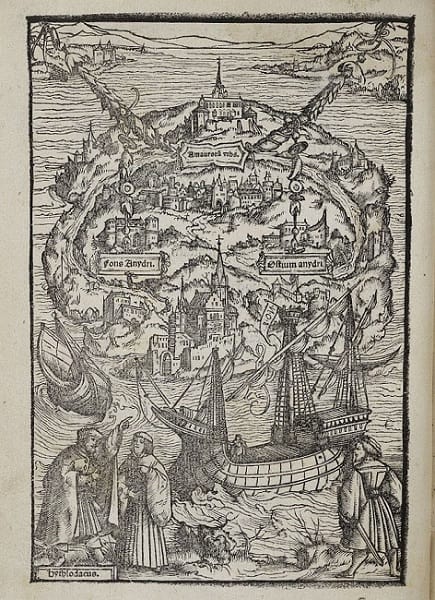
Utopian thinking, and consequently utopian architecture, has emerged in alternating phases throughout history, always characterizing great moments of cultural ferment and desire for renewal, especially during the early Renaissance, the period around the French Revolution and the Twentieth Century.
“The home of the Utopian impulse was architecture rather than painting or sculpture. Painting can make us happy, but building is the art we live in; it is the social art par excellence, the carapace of political fantasy, the exoskeleton of one’s economic dreams. It is also the one art nobody can escape.”
Robert Hughes
Renaissance ‘Ideal City’
With the advent of fifteenth-century humanism, which renewed the affirmation of humankind’s centrality, along with the rediscovery of art and classical architecture as well as the recent invention of perspective, the theme of the “ideal city” was brought back to the center of the debate. The Renaissance idea involved an urban design reflecting a predominantly geometric scheme, founded on criteria of rationality, but also with the ambition to combine functional requirements with an inspired aesthetic sensitivity.
The unknown painter of The Ideal City – some attribute it to Piero Della Francesca or Melozzo da Forlì, while others have suggested Leon Battista Alberti or Luciano Laurana as the author – represented the absolute model of the Renaissance city: conceived as a chessboard where the polychrome marbled streets reflect and amplify the city’s status and structure; the buildings, just like chessboard pieces, are placed at regular intervals of space, according to canons of absolutist precision, including, amongst other precepts, the golden ratio and Euclidean geometry.

Since the second half of the fifteenth century, there were some attempts to commit theory into practice, respecting the ideal requirements of aesthetics, rationality, and balance between functionalities: including representations of authority (the palace), defence (fortifications), habitation (housing structures) and, finally, entertainment (the theatre), and also including other elements such as piazze, which serve both to aggrandize but also provide places where public gathering can happen.
The actual practical achievements were few in number, but some can still be admired. Among the most spectacular cases is the city of Palmanova, a concentric fortress town with radiant streets in northern Italy. Founded by the Venetian Republic and designed by the architect Vincenzo Scamozzi in 1593, the city was an extremely innovative example of an urban settlement that involved the use of all the latest military devices. Also Urbino, Pienza, and Ferrara, in Italy as well, have been planned according to utopian ideals.

Revolutionary Architects
In the second half of the 18th century, at the height of the French Enlightenment, a group of architects returned to classicism and the purity of simple geometric forms, but with a philosophical focus on the writings of philosophers such as Rousseau and Burke.
Among them, the most influential were Étienne-Louis Boullée and Claude-Nicolas Ledoux, often referred to as “visionary architects” or “revolutionary architects” as they interpreted the changes as linked to the French Revolution – though without getting actually involved in it. Architecture had become a discipline capable of redeeming from ignorance, prejudice, and obscurantism.
The architecture of this time was characterized by an intense ethical and symbolic value. It was also defined as “talking architecture” because of its ability to communicate and evoke moral values and civil virtues through symbolism and allusion. Projects were not unfeasible, yet also ambitious, making them strongly utopian both in philosophical terms, but also in their likelihood of being realized. According to Boullée, architecture was like poetry: valuable only if capable of arousing strong feelings. Beauty lay in symmetry, proportion and variety, and the sphere, composed of these characters altogether, was the perfect shape.
His style, monumental yet devoid of all unnecessary ornamentation, found its maximum expression in the design of the Cenotaph for Sir Isaac Newton (1784): a colossal hollow sphere, more than one-hundred-and-fifty meters high, surrounded on the outside by concentric rings of cypresses, and arranged on three levels, as in ancient Roman mausoleums.
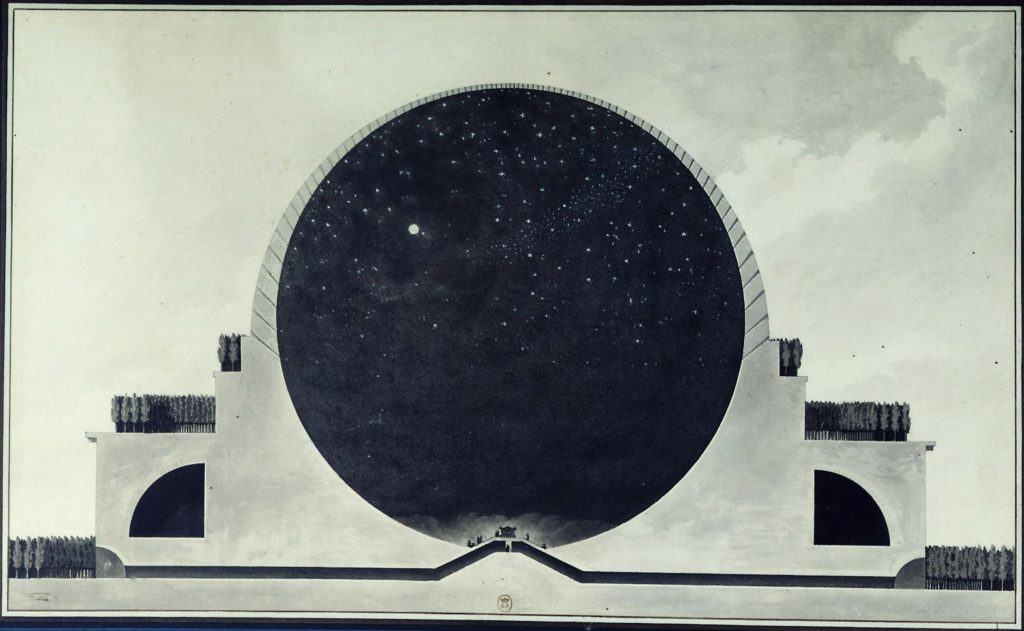
Externally, the sphere was intended to represent the Earth, while encased inside the volume was the celestial vault. Convexity and concavity expressed a paradox of the human mind: confined by certain limits, yet able to conceptually grasp the infinity of the universe. Due to the inadequacy of the materials and construction processes of the time the project was never realised.
With almost no surviving built works and only suggestive drawings and engravings to support his fame, Boullée was almost entirely forgotten until the art historian Emil Kaufmann, in the late 1920s, rediscovered his work, ensuring he would exert a strong influence over generations of 20th-century architects.
More notorious was his younger colleague Claude-Nicolas Ledoux. Like Boullée, he was disinterested in buildings’ usability and functionality, but instead preferring to emphasize the poetic aspect of architecture, Ledoux’s ambition was to affirm the social role of the architect as a political, educational, and moral reformer of modern times.
His most grandiose utopian project was the visionary plan for the ideal city of Chaux, as an expansion of the Royal Saltworks at Arc-et-Senans. The work actually started in 1775 but was interrupted a few years later and never completed.

The project was supposed to inculcate a rational geometry with a hierarchical relation between the parts, but also incorporate a radical symbolism that associated the shape of a building with its function. For instance, the house for the river watchmen was designed as a hollow cylinder inside which the watercourse was meant to flow. His ideas did not reach the solemnity of Boullée’s but exemplified the ideal of an architecture supporting social reform, which has often led him to be presented as a precursor of modern social reform in architecture.
Utopian Vision in the Early 20th Century
At the beginning of the 20th century, constantly accelerating industrial production made new materials possible and widely available, including glass in large panes, steel, and reinforced concrete, all of which sparked the imagination of avant-garde architects. Different artistic movements found in these new materials and manufacturing techniques the inspiration to dream of a modern world about to come, yet also tantalizingly within reach. The Futurists, in particular, were obsessed with innovation and saw themselves as pioneers imbued with a mission to create a new civilization; they declared “We stand on the last promontory of the centuries! (…) Why should we look back, when what we want is to break down the mysterious doors of the Impossible?”. Out with classical references and simple volumes but forward with dynamism and speed, the hallmarks of a new technocratic society.
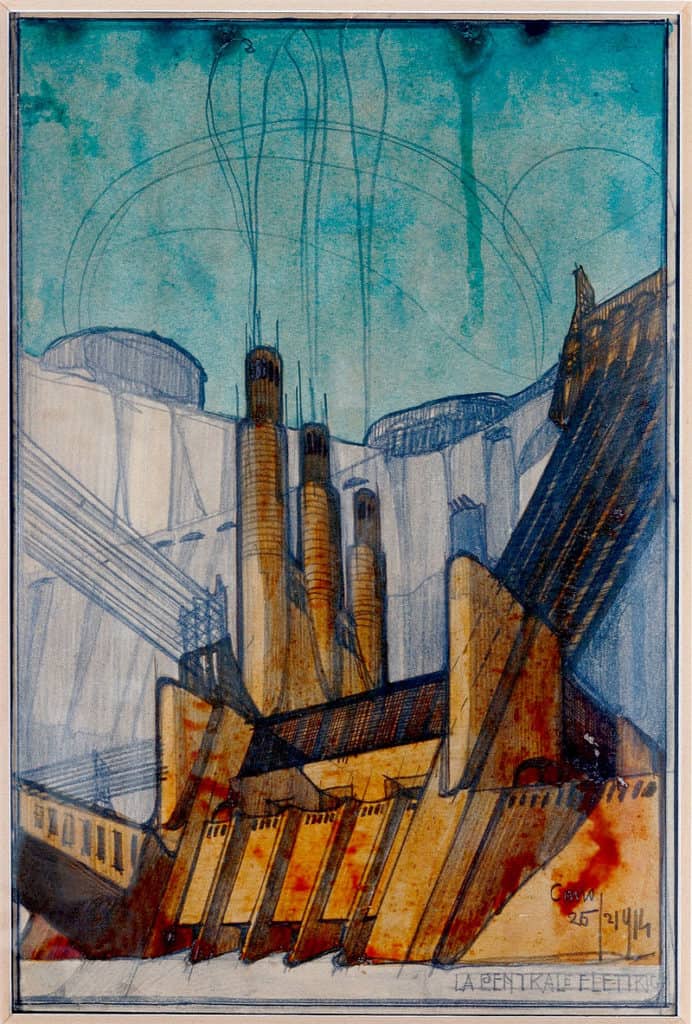
The Italian architect Antonio Sant’Elia embraced the twin ideals of mechanization and motion, proposing a vision of a modern city in the form of a gigantic machine; he named it Città Nuova (“New City”), a name quite contextually appropriate. This futurist city, designed between 1912 and 1914, was a vast, multi-level, interconnected urban conurbation where massive skyscrapers were integrated by elevators, bridges, and elevated walkways in a constantly evolving artificial landscape. Paradoxically, Sant’Elia, like many other Futurists, saw warfare as the means to destroy the old world and build the much sought-after future. However, it was the entropy of war itself that would shatter their illusions, destroying not only the socio-economic conditions necessary to facilitate such grandiose plans but also its main protagonists–Sant’Elia was himself killed in a battle at the age of twenty-eight with almost no completed works of architecture left behind. Nonetheless, if his sketches seem familiar,, it is because his utopian visions have inspired masterpieces of cinema like Fritz Lang’s Metropolis (1927) and Ridley Scott’s Blade Runner (1982).
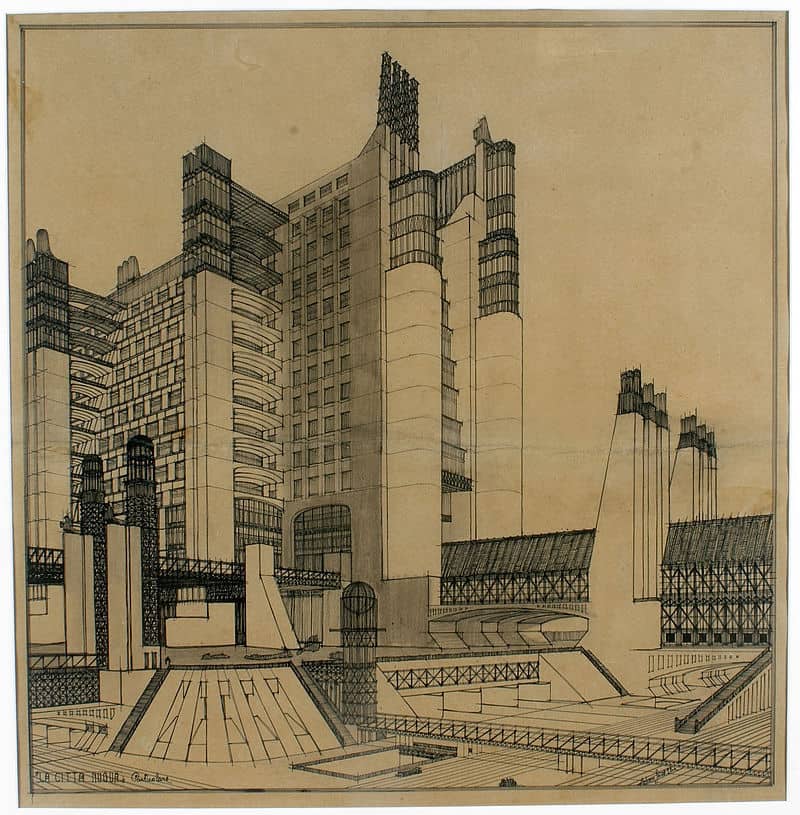
At the same time, on the other side of Europe, Russian artists and architects were searching for a new communist aesthetic, also intended to be both symbolic and monumental. Reminiscent of Cubist and Futurist examples, Constructivist architecture merged the former’s abstract geometry with the latter’s dynamism and technological character.
Projects often included propagandistic imagery and the promise of a renewed industrialized society. Unfortunately, many ideas were far too ambitious and collided with the USSR’s practical reality. Among the many unrealized – and unrealizable – projects, stands the Monument to the Third International designed by Vladimir Tatlin, also known as Tatlin’s Tower. The spiral construction, around four hundred meters high, should have been built from industrial materials as a socialist symbol of modernity, and a direct counterpart, and competitor, to the Eiffel Tower.
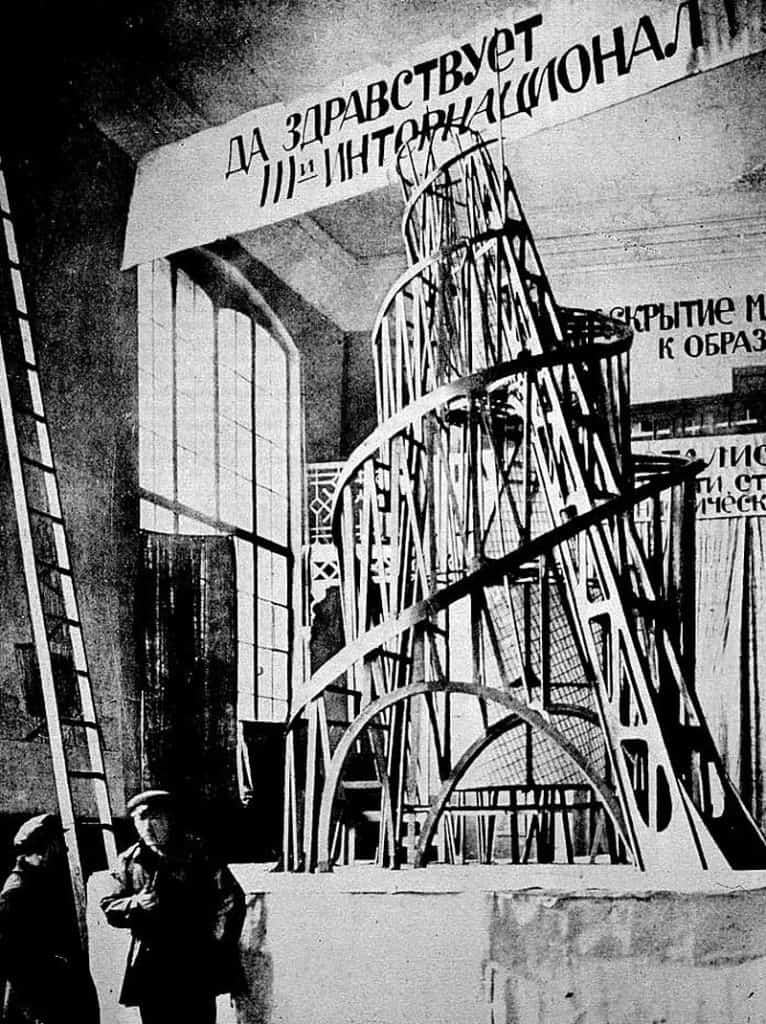
Two of the most renowned masters of 20th-century architecture have also ventured into utopian architecture; both Le Corbusier and Frank Lloyd Wright tried their hand at regenerative schemes infused with social function.
The French-Swiss architect was frustrated by the way Paris’ urban plan seemed to exacerbate economic segregation: while the bourgeois tended to inhabit the city center where land prices were rising tremendously, lower classes were pushed to overcrowded suburbs where they lived in inhuman conditions and where epidemics were commonplace.
Strongly believing that an efficient urban design could not only improve city life but the entirety of society, Le Corbusier decided, in 1925, to plan a redevelopment of central Paris. His idea, named Plan Voisin, was extremely radical and involved demolishing two square miles of downtown Paris to build eighteen widely spaced, 60-story cruciform towers, placed on a rectangular grid in an enormous green space. This high-density housing right in the city center would have shortened the commuting distances and encouraged rapid intercommunication. Concerning the plan, Le Corbusier wrote: “Paris of tomorrow could be magnificently equal to the march of events that is day by day bringing us ever nearer to the dawn of a new social contract”. His utopian vision never left the drafting table.
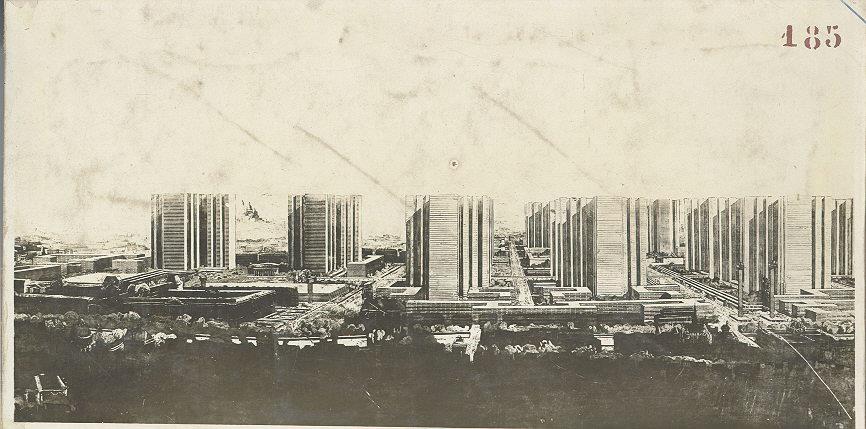
In opposition to Le Corbusier’s idea of a densely populated city was Frank Lloyd Wright’s proposal: his main objective was the perfect harmony between built and natural environment, so in 1932 he imagined his own utopia, Broadacre City, where a minimum of one acre of ground was assigned to each household. In essence, he removed almost everything that was remotely urban, except for private cars to which the streets were entirely dedicated – pedestrians could only safely exist within the confines of the one-acre – and “aerators”, air travel devices that could take off and land vertically with no need of a landing strip, again one for each family. Although he never managed to build Broadacre City, some of its principles are the core of today’s American suburbs.
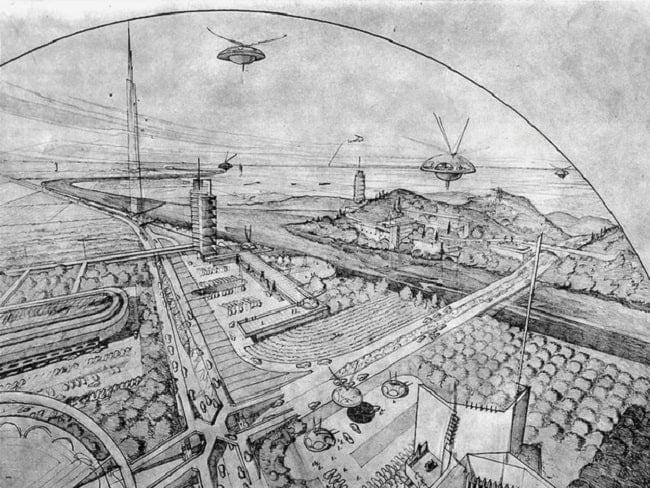
Utopian Visions in the 1960s and 1970s
A new wave of utopian visions characterized the decades following World War II. On the one hand, there was a real need to rebuild cities after the wreckage of war, and on the other an urge to replace the prevailing societal ills that had fomented such catastrophic conflict in the first place. The 1960s and, to a lesser extent, the 1970s, conveyed feelings of optimism and possibility, a renewed spirit of community, and the sense that broader possibilities than ever before existed – scientifically, politically as well as artistically.
Among the most radical ideas, Paolo Soleri conceived ‘arcology‘, a combination of architecture and ecology, and designed to create a democratic society. The Italian architect, once settled in the United States, considered life in the American suburbs unhappy, unhealthy, and wasteful, and a cause of self-isolation and social degradation. In response he designed low-impact, highly dense structures; buildings so enormous they exist as city entities unto themselves–compact and energy-efficient volumes where private means of transport did not exist and the most convenient way to get around was walking.
His ideal city was an organism in which everyone and everything was part of a larger whole. For instance, Hexahedron Arcology, one of his most visionary projects, was a sort of artificial mountain in the shape of two pyramids, one straight, one inverted, hosting 170,000 residents.
In 1970, in the middle of the desert in central Arizona, Soleri began to build a prototype city emblematic of ‘arcology’, with the aim of maximising human interaction, enjoying nature, the use of available local resources, a minimized use of energy, and a significant reduction in waste and environmental pollution. The city, called Arcosanti, has been in construction ever since as an extreme experimental project and is one of the rare examples of utopian architecture whose realization has come close to its hypothetical model.
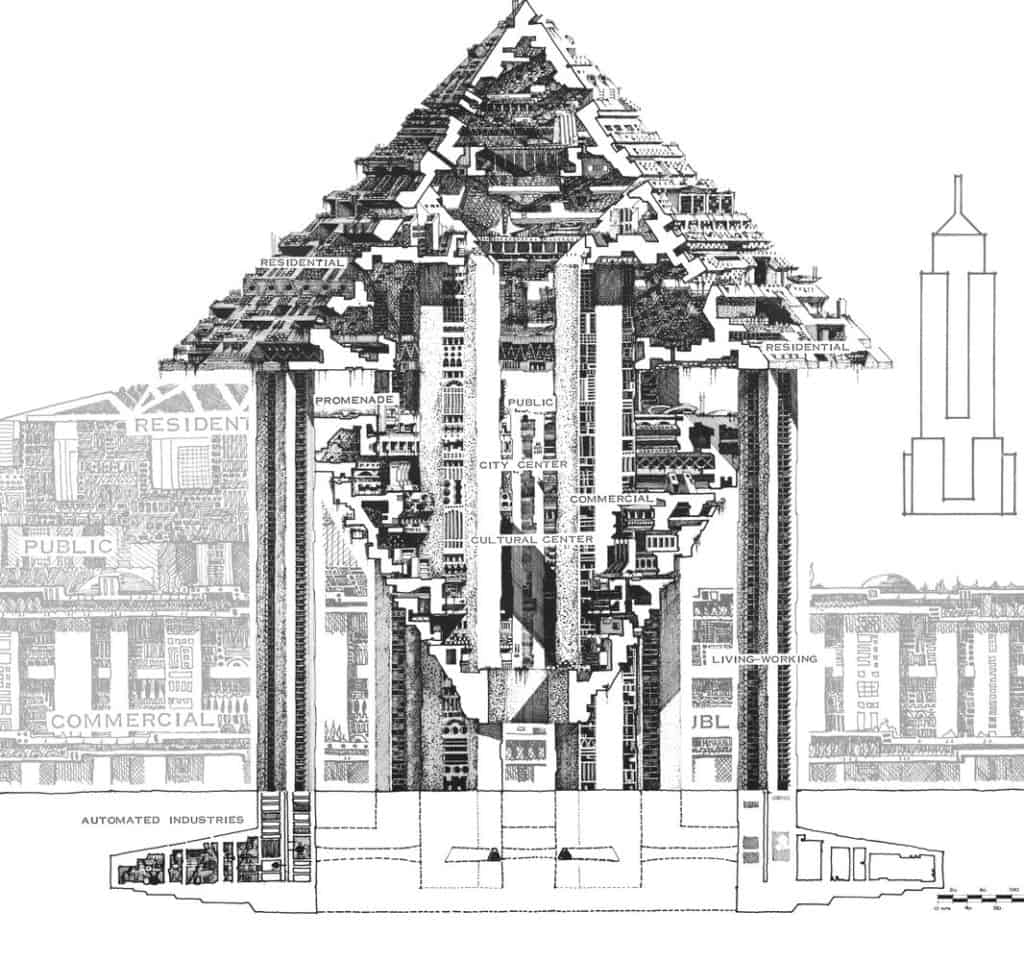
But most of all, the 1960s and 1970s were the years of architecture collectives, utopian groups that saw architecture as an instrument of political, social, and cultural critique.
Among the best known, Archizoom and Super Studio in Italy, Ant Farm in San Francisco, and especially Archigram in the UK. The latter, formed in London in 1961, employed unusual media and formats, such as collages, zines, comic strips, and radical statements to spread the vision of pop, high-tech, consumerist cities. Their work was mainly imaginative and provocative, and their playful and dynamic cities like Plug-in City and Instant City had no presumption of actual realization.
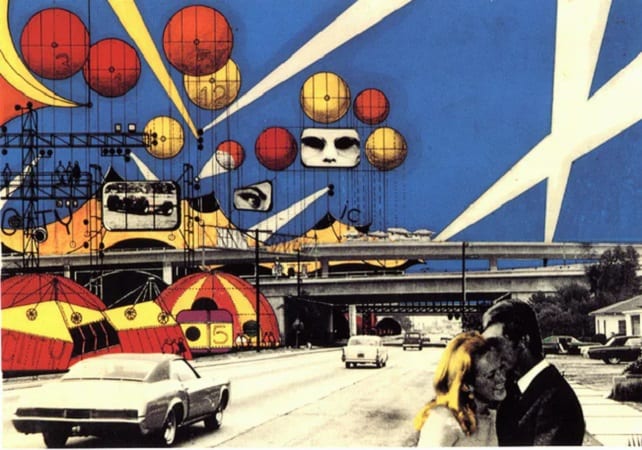
Still today, after centuries and centuries of ideas and false starts, the dream society and the architecture for it to live in seem to be unreachable. Challenges such as inequality, climate change, food and water scarcity, and the overcrowding of urban areas impend over humanity. Perhaps utopian thinkers and utopian architecture may yet have their most significant role to play.
Relevant sources to learn more
Le Corbusier Foundation
Frank Lloyd Wright Foundation
Arcosanti Project
Ant Farm
Archigram
Brutalist Architecture: The Defining Style of the 20th Century?
Gesamtkunstwerk. The Total Work Of Art Through The Ages.